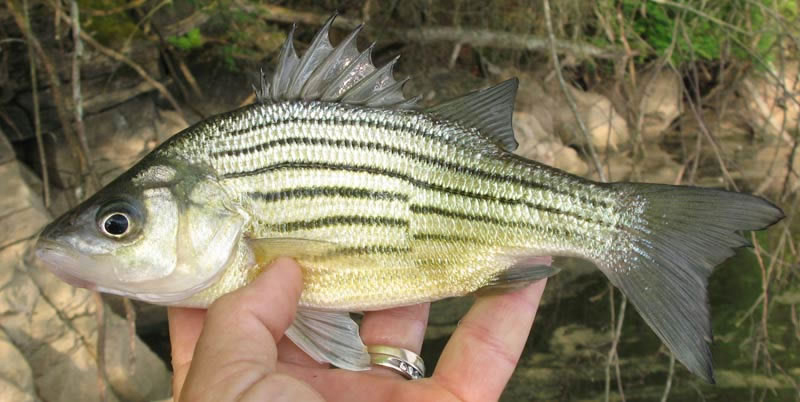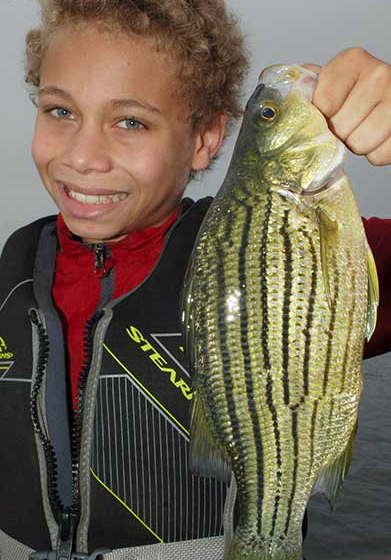This underappreciated native fish species is usually an incidental bycatch, most often taken by crappie anglers casting or drifting small jigs, or fishing live minnows around submerged wood cover.
The Yellow Bass (Morone mississippiensis) is a member of the temperate bass family Moronidae, that includes the striped bass, white bass and hybrid striped bass.
Some anglers fishing in Kentucky Lake and Lake Barkley during the spring crappie spawn consider the Yellow Bass a nuisance. The main problem seems to be that it’s often hard to avoid catching them if they are schooled up in the area being fished.
The Kentucky state record Yellow Bass weighed just 1 pound, 6.4 ounces and was caught from the Lake Barkley tailwaters on March 19, 2009.
What this fish lacks in size it makes up as table fare. Yellow Bass fillets are tasty when fried up and served with the traditional meal of french fries, hush puppies, coleslaw and/or potato salad.
Size and Coloration
The Yellow Bass is similar in appearance to the White Bass, but its head is more slender. The body is greenish above, but its sides are a brassy yellow color, rather than silver and white like the White Bass.
Its sides have wide, dark stripes that are broken, and offset downward in front of the anal fin. Its two dorsal fins are connected by a membrane and may be tinged with blue or green. The scales are rough to the touch.
Spawning runs into tributary streams and occurs in the spring when water temperatures climb into the mid-60s.
“Yellow Bass reproduce at a high rate,” said Jeff Ross, Assistant Director of the Fisheries Division for the management districts of the Kentucky Department of Fish and Wildlife Resources (KDFWR). “We have seen a few instances where they hybridize with White Bass.”
The Yellow Bass is the smallest of the four temperature bass species in Kentucky, reaching a maximum length of just 12 to 15 inches.

Distribution in Kentucky
In The Fishes of Kentucky, published in 1975, author William M. Clay wrote that the distribution of the Yellow Bass is “characteristic of the large streams and impoundments of the western part of the state, less abundant in ponds and sloughs (natural wetlands).”
Today, the Yellow Bass occurs in the western third of the state, with a few exceptions, primarily in lower Cumberland River, lower Tennessee River, Mississippi River, lower Ohio River and Green River basins.
The fisheries in Kentucky Lake, Lake Barkley and Barren River Lake are rated excellent.
Food Habits
Juvenile Yellow Bass feed on small invertebrates.
This includes small crustaceans (copepods), and insects that spend some portion of their life cycle in water, such as mayflies, stoneflies, beetles and caddisflies.
As adults they feed primarily on forage fishes — shad, shiners and other minnows — and benthic invertebrates (bottom-dwelling) and their larvae.
Fishing Tips
Since Yellow Bass are rather small most anglers fish with panfish gear, typically an ultra-light to medium-light action 6-foot rod with a spinning reel spooled in 6-pound test monofilament line.
A small lead-head jig is one of the most popular artificial lures used, with 1/16th-ounce being preferred. Jigs with a plastic curly tail skirt are popular. Other productive artificial lures include inline spinners such as a Mepps or Roostertail, or tiny crankbaits.
Fishing with live bait is another way to catch Yellow Bass, usually small shad, shiners, fathead minnows or bits of nightcrawler.
Fish your lure or bait on or within six inches of the bottom since these fish feed heavily on invertebrates in the substrate, rocks, gravel, sand and silt.
Yellow Bass like to school up. Once you find a school, stay with them. You will be rewarded with large stringers of scrappy fighting fish that are delicious to eat.
Creel Limits:
“At one time there was a 30-fish daily creel limit on Yellow Bass at Kentucky Lake and Lake Barkley, but that was removed years ago,” said Ross. “There never has been an issue with low numbers of Yellow Bass.”
Today, statewide, there’s no daily creel limit or minimum size limit on Yellow Bass, and biologists recommend harvesting them when caught.
This underappreciated, abundant native fish species is small but tasty table fare. Don’t overlook this excellent fishing opportunity.
"tasty" - Google News
June 26, 2020 at 11:41AM
https://ift.tt/3fWFGLp
Art Lander's Outdoors: The yellow bass is a small, underappreciated species, but makes a tasty meal - User-generated content
"tasty" - Google News
https://ift.tt/2VXquX3
https://ift.tt/3c08sJp
Bagikan Berita Ini
















0 Response to "Art Lander's Outdoors: The yellow bass is a small, underappreciated species, but makes a tasty meal - User-generated content"
Post a Comment